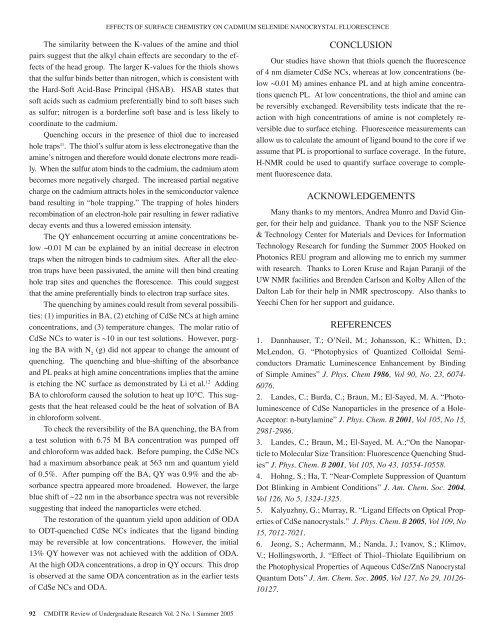Student Project Abstracts 2005 - Pluto - University of Washington
Student Project Abstracts 2005 - Pluto - University of Washington
Student Project Abstracts 2005 - Pluto - University of Washington
Create successful ePaper yourself
Turn your PDF publications into a flip-book with our unique Google optimized e-Paper software.
EFFECTS OF SURFACE CHEMISTRY ON CADMIUM SELENIDE NANOCRYSTAL FLUORESCENCEThe similarity between the K-values <strong>of</strong> the amine and thiolpairs suggest that the alkyl chain effects are secondary to the effects<strong>of</strong> the head group. The larger K-values for the thiols showsthat the sulfur binds better than nitrogen, which is consistent withthe Hard-S<strong>of</strong>t Acid-Base Principal (HSAB). HSAB states thats<strong>of</strong>t acids such as cadmium preferentially bind to s<strong>of</strong>t bases suchas sulfur; nitrogen is a borderline s<strong>of</strong>t base and is less likely tocoordinate to the cadmium.Quenching occurs in the presence <strong>of</strong> thiol due to increasedhole traps 11 . The thiol’s sulfur atom is less electronegative than theamine’s nitrogen and therefore would donate electrons more readily.When the sulfur atom binds to the cadmium, the cadmium atombecomes more negatively charged. The increased partial negativecharge on the cadmium attracts holes in the semiconductor valenceband resulting in “hole trapping.” The trapping <strong>of</strong> holes hindersrecombination <strong>of</strong> an electron-hole pair resulting in fewer radiativedecay events and thus a lowered emission intensity.The QY enhancement occurring at amine concentrations below~0.01 M can be explained by an initial decrease in electrontraps when the nitrogen binds to cadmium sites. After all the electrontraps have been passivated, the amine will then bind creatinghole trap sites and quenches the florescence. This could suggestthat the amine preferentially binds to electron trap surface sites.The quenching by amines could result from several possibilities:(1) impurities in BA, (2) etching <strong>of</strong> CdSe NCs at high amineconcentrations, and (3) temperature changes. The molar ratio <strong>of</strong>CdSe NCs to water is ~10 in our test solutions. However, purgingthe BA with N 2(g) did not appear to change the amount <strong>of</strong>quenching. The quenching and blue-shifting <strong>of</strong> the absorbanceand PL peaks at high amine concentrations implies that the amineis etching the NC surface as demonstrated by Li et al. 12 AddingBA to chlor<strong>of</strong>orm caused the solution to heat up 10°C. This suggeststhat the heat released could be the heat <strong>of</strong> solvation <strong>of</strong> BAin chlor<strong>of</strong>orm solvent.To check the reversibility <strong>of</strong> the BA quenching, the BA froma test solution with 6.75 M BA concentration was pumped <strong>of</strong>fand chlor<strong>of</strong>orm was added back. Before pumping, the CdSe NCshad a maximum absorbance peak at 563 nm and quantum yield<strong>of</strong> 0.5%. After pumping <strong>of</strong>f the BA, QY was 0.9% and the absorbancespectra appeared more broadened. However, the largeblue shift <strong>of</strong> ~22 nm in the absorbance spectra was not reversiblesuggesting that indeed the nanoparticles were etched.The restoration <strong>of</strong> the quantum yield upon addition <strong>of</strong> ODAto ODT-quenched CdSe NCs indicates that the ligand bindingmay be reversible at low concentrations. However, the initial13% QY however was not achieved with the addition <strong>of</strong> ODA.At the high ODA concentrations, a drop in QY occurs. This dropis observed at the same ODA concentration as in the earlier tests<strong>of</strong> CdSe NCs and ODA.CONCLUSIONOur studies have shown that thiols quench the fluorescence<strong>of</strong> 4 nm diameter CdSe NCs, whereas at low concentrations (below~0.01 M) amines enhance PL and at high amine concentrationsquench PL. At low concentrations, the thiol and amine canbe reversibly exchanged. Reversibility tests indicate that the reactionwith high concentrations <strong>of</strong> amine is not completely reversibledue to surface etching. Fluorescence measurements canallow us to calculate the amount <strong>of</strong> ligand bound to the core if weassume that PL is proportional to surface coverage. In the future,H-NMR could be used to quantify surface coverage to complementfluorescence data.ACKNOWLEDGEMENTSMany thanks to my mentors, Andrea Munro and David Ginger,for their help and guidance. Thank you to the NSF Science& Technology Center for Materials and Devices for InformationTechnology Research for funding the Summer <strong>2005</strong> Hooked onPhotonics REU program and allowing me to enrich my summerwith research. Thanks to Loren Kruse and Rajan Paranji <strong>of</strong> theUW NMR facilities and Brenden Carlson and Kolby Allen <strong>of</strong> theDalton Lab for their help in NMR spectroscopy. Also thanks toYeechi Chen for her support and guidance.REFERENCES1. Dannhauser, T.; O’Neil, M.; Johansson, K.; Whitten, D.;McLendon, G. “Photophysics <strong>of</strong> Quantized Colloidal SemiconductorsDramatic Luminescence Enhancement by Binding<strong>of</strong> Simple Amines” J. Phys. Chem 1986, Vol 90, No. 23, 6074-6076.2. Landes, C.; Burda, C.; Braun, M.; El-Sayed, M. A. “Photoluminescence<strong>of</strong> CdSe Nanoparticles in the presence <strong>of</strong> a Hole-Acceptor: n-butylamine” J. Phys. Chem. B 2001, Vol 105, No 15,2981-2986.3. Landes, C.; Braun, M.; El-Sayed, M. A.;“On the Nanoparticleto Molecular Size Transition: Fluorescence Quenching Studies”J. Phys. Chem. B 2001, Vol 105, No 43, 10554-10558.4. Hohng, S.; Ha, T. “Near-Complete Suppression <strong>of</strong> QuantumDot Blinking in Ambient Conditions” J. Am. Chem. Soc. 2004,Vol 126, No 5, 1324-1325.5. Kalyuzhny, G.; Murray, R. “Ligand Effects on Optical Properties<strong>of</strong> CdSe nanocrystals.” J. Phys. Chem. B <strong>2005</strong>, Vol 109, No15, 7012-7021.6. Jeong, S.; Achermann, M.; Nanda, J.; Ivanov, S.; Klimov,V.; Hollingsworth, J. “Effect <strong>of</strong> Thiol–Thiolate Equilibrium onthe Photophysical Properties <strong>of</strong> Aqueous CdSe/ZnS NanocrystalQuantum Dots” J. Am. Chem. Soc. <strong>2005</strong>, Vol 127, No 29, 10126-10127.92 CMDITR Review <strong>of</strong> Undergraduate Research Vol. 2 No. 1 Summer <strong>2005</strong>




